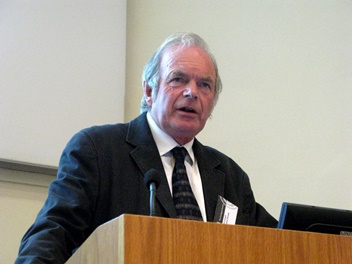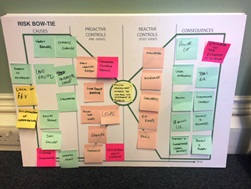 Flo Bullough on the first ever two-day interdisciplinary Bryan Lovell Meeting, held in November.
Flo Bullough on the first ever two-day interdisciplinary Bryan Lovell Meeting, held in November.
This new flagship meeting series, named for Dr Bryan Lovell (President 2010 - 12 - picture), aims to address ‘societal challenges’ as they relate to geoscience. The name recognises the significant work that Bryan has done, both as President and more widely, to bring together geoscience expertise and policymakers to develop more robust, evidence-informed policies. (Many of the topics where geoscience and policy intersect are mapped out in the Society’s ‘Geology for Society’ report which you can find at www.geolsoc.org/geology-for-society.)
Interdisciplinary themes
The first meeting focused on the Society’s 2016 and 2017 themes, ‘Water’ and ‘Risk’, and took a broad view of hazard understanding, mitigation and communication. Important intersecting issues - such as surface and groundwater flooding, sinkholes, drought and water security - were discussed from the perspectives of those in research, engineering, local and national government and risk management, modelling and communication.
To stimulate discussion around the cross-disciplinary themes of risk and uncertainty we ran an activity using the ‘Bow Tie’ method (picture). This is a risk assessment and communication tool that allows participants to visualise the causes, effects and controls around a given risk in a single picture. The method was introduced during the opening session and several ‘Bow Ties’ were then populated by delegates and reviewed at the end of the meeting.
 The meeting opened with a policy briefing session featuring a keynote talk from Professor Ian Boyd, Chief Scientific Adviser to the Department for Environment, Food and Rural Affairs (DEFRA), setting out the view from government on UK hazards such as flooding and climate change, and the challenges for policy-makers in dealing with risk and uncertainty. This introduced a key driver for the meeting - thinking about geoscience as it relates to policy and governance - and set the focus for later discussions.
The meeting opened with a policy briefing session featuring a keynote talk from Professor Ian Boyd, Chief Scientific Adviser to the Department for Environment, Food and Rural Affairs (DEFRA), setting out the view from government on UK hazards such as flooding and climate change, and the challenges for policy-makers in dealing with risk and uncertainty. This introduced a key driver for the meeting - thinking about geoscience as it relates to policy and governance - and set the focus for later discussions.
Day 1 also featured talks on water as a resource and a hazard and aspects of environmental change, including the 2015 ‘Hertfordshire sinkhole’, groundwater flooding in the UK, water policy and working with government - as well as water remediation, security and the water-energy nexus.
Day 2 began with a keynote from Jenny Cooke (Network Rail), looking at the interaction between water, risk and the railways as a practical example of how low-to-high impact geohazards can affect engineering risk and delivery of infrastructure services. This was followed by talks and discussions around risk and uncertainty in ground engineering, (re)insurance, catastrophe modelling, corporate water risk and stewardship, as well as groundwater risk and flood management. The meeting closed with a session of talks and discussions on the public understanding of the subsurface and risk as well as effective communication of risk and uncertainty to the various stakeholders affected by water-related geohazards.
What next?
Effective communication about the subsurface, risk and uncertainty, as well as improved education, were identified as key areas that need to be addressed across the geoscience community if we are to improve geoscience advice to government and decision-makers. In the closing session we discussed the different outputs that could stem from the meeting, including recommendations to policymakers. We plan to produce a meeting report which will be published on the website, and to develop a risk communication best-practice toolkit for geoscientists.
You can read more about the meeting, including videos of talks from the conference and information on the ‘Bow Tie’ method at: www.geolsoc.org.uk/Lovell16. This page will also be updated with outputs from the meeting.